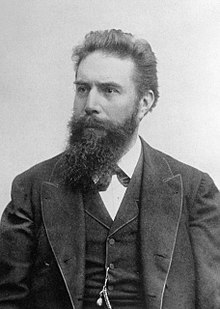
Wilhelm Conrad Röntgen
- Nobelpreis für Physik 1901
Navigation auf uzh.ch

1865 Studies at the Federal Polytechnic Institute (today ETH) Zurich
1868 Diploma as mechanical engineer
1869 Doctorate in physics from the University of Zurich
1870 Assistant at the Old University of Würzburg
1872 Assistant at the University of Strasbourg
1874 Habilitation
1875 Lecturer for Physics and Mathematics at the Agricultural Academy Hohenheim near Stuttgart
1876-1987 Lecturer in Strasbourg
1879-1888 Professor in Giessen
1888-1900 Professor in Würzburg
1900-1920 Professor in Munich
1920 Professor Emeritus
On November 8, 1895, while working with cathode ray tubes, Conrad Röntgen discovered unknown radiation, which he called X-rays in his publication "Über eine neue Art von Strahlen" (On a new type of radiation) published shortly afterwards. He worked at the time as a professor of theoretical physics in Würzburg. He found out that the rays penetrate materials differently depending on their density and produced the first X-ray images by directing the rays onto a photo plate.
He also worked on the quadratic electro-optic (QEO) effect, which is a change in the refractive index of a material in response to an applied electric field (Kerr effect), was able to prove that a magnetic effect occurs in a dielectric moved between electrically charged capacitor plates (X-ray current) and could verify the displacement current predicted by Maxwell's theory.
1896: Rumford Medal
1896: Matteucci Medal
1897: Elliott Cresson Medal
1901: Nobepreis